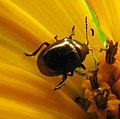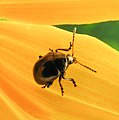Eumolpini is a tribe of leaf beetles in the subfamily Eumolpinae. It is the largest tribe in the subfamily, with approximately 170 genera found worldwide. Members of the tribe almost always have a longitudinal median groove on the pygidium, which possibly helps to keep the elytra locked at rest. They also generally have a subglabrous body, as well as appendiculate pretarsal claws.[2][3]
| Eumolpini | |
|---|---|
 | |
| Brachypnoea | |
| Scientific classification | |
| Domain: | Eukaryota |
| Kingdom: | Animalia |
| Phylum: | Arthropoda |
| Class: | Insecta |
| Order: | Coleoptera |
| Infraorder: | Cucujiformia |
| Family: | Chrysomelidae |
| Subfamily: | Eumolpinae |
| Tribe: | Eumolpini Hope, 1840 |
| Synonyms | |
Taxonomy
Following the leaf beetle classification of Seeno and Wilcox (1982), the genera of Eumolpini are divided into five informal groups or "sections": Corynodites, Edusites, Endocephalites, Eumolpites and Iphimeites.[4]
In the Catalog of the leaf beetles of America North of Mexico, published in 2003, the section Myochroites of Bromiini was placed in synonymy with the section Iphimeites in Eumolpini. The North American genera Glyptoscelis and Myochrous from Myochroites were also transferred to Iphimeites.[5]
Genera
These 172 genera belong to the tribe Eumolpini:[6][7][8][9][10][11][12][13][14][15][16][17]
- Abiromorphus Pic, 1924
- Abirus Chapuis, 1874[1]
- †Acolaspoides Moseyko, Kirejtshuk & Nel, 2010[18]
- Acronymolpus Samuelson, 2015[19]
- Adorea Lefèvre, 1877[20]
- Aemnestus Jacoby, 1908[21]
- Agbalus Chapuis, 1874[1]
- Agetinus Lefèvre, 1885[22]
- Agrianes Chapuis, 1874[1]
- Agrosterna Harold, 1875
- Ajubus Aslam, 1968[23]
- Alethaxius Lefèvre, 1885[22]
- Alittus Chapuis, 1874[1]
- Allocolaspis Bechyné, 1950[24]
- Anachalcoplacis B. Bechyné, 1983[25]
- Anchieta Bechyné, 1954[26]
- Antitypona Weise, 1921
- Apterodina Bechyné, 1954[26]
- Argoa Lefèvre, 1885[22]
- Aristonoda Bechyné, 1953
- Arnobiopsis Jacoby, 1896[27]
- Arsoa Fairmaire, 1901
- Atrichatus Sharp, 1886
- Aulacia Baly, 1867[28]
- Auranius Jacoby, 1881[29]
- Australotymnes Flowers, 2009[30]
- Balya Jacoby, 1882
- Beltia Jacoby, 1881[31]
- Brachypnoea Gistel, 1848
- Callicolaspis Bechyné, 1950[32]
- Caudatomolpus Bechyné, 1953
- Cazeresia Jolivet, Verma & Mille, 2005
- Chalcophana Chevrolat in Dejean, 1836
- Chalcophyma Baly, 1865[33]
- Chalcoplacis Chevrolat in Dejean, 1836
- Chrysochares Morawitz, 1861[34]
- Chrysochus Chevrolat in Dejean, 1836
- Chrysodinopsis Bechyné, 1950[32]
- Chrysolampra Baly, 1859[35]
- Cleptor Lefèvre, 1885[22]
- Clisithera Baly, 1864[36]
- Colaspedusa Medvedev, 1998[37]
- Colaspinella Weise, 1893
- Colaspis Fabricius, 1801
- Colaspoides Laporte, 1833
- Corumbaea Bechyné, 1954[26]
- Corysthea Baly, 1865[33]
- Costalimaita Bechyné, 1954[26]
- Coytiera Lefèvre, 1875
- Cudnellia Blackburn, 1890
- Dematochroma Baly, 1864
- Dematotrichus Gómez-Zurita, 2022[38]
- Dermorhytis Baly, 1861[39]
- Deuteronoda Bechyné, 1951[40]
- Dorysternoides Bechyné & Bechyné, 1967
- Drakhshandus Aslam, 1968[23]
- Dryadomolpus Bechyné & Bechyné, 1969[41]
- Dumbea Jolivet, Verma & Mille, 2007
- Durangoita Bechyné, 1958
- Edusella Chapuis, 1874[1]
- Edusoides Blackburn, 1889
- Endocephalus Chevrolat in Dejean, 1836
- Endoschyrus Jacoby, 1901
- Entomochirus Lefèvre, 1884[42]
- †Eocenocolaspis Bukejs, Moseyko & Alekseev, 2022[43]
- Epiphyma Baly, 1860
- Erotenia Lefèvre, 1884[42]
- Eucampylochira Bechyné, 1951[40]
- Eucolaspinus Lea, 1916
- Eucolaspis Sharp, 1886
- Eumolpus Weber, 1801
- Eupetale Flowers, 2021[44]
- Euphrytus Jacoby, 1881[31]
- Eurysarcus Lefèvre, 1885[22]
- Exochognathus Blake, 1946[45][46]
- Fractipes Bechyné, 1950
- Frenais Jacoby, 1903
- Freudeita Bechyné, 1950[47]
- Freycolaspis Scherer, 1964
- Geloptera Baly, 1861[39]
- Glyptoscelis Chevrolat in Dejean, 1836 (formerly in Adoxini)
- Glyptosceloides Askevold & Flowers, 1994[48]
- Guyanica Chevrolat in Dejean, 1836
- Heminodes Jacoby, 1895[49]
- Hermesia Lefèvre, 1877[50][51]
- Hermesilla Bechyné, 1954[26]
- Hylax Lefèvre, 1884
- Hypoderes Lefèvre, 1877[20]
- Iphimeis Baly, 1864
- Iphimoides Jacoby, 1883
- Iphimolpus Bechyné, 1949[52]
- Ischyrolampra Lefèvre, 1885[22]
- Ischyrolamprina Bechyné, 1950[32]
- Isolepronota Bechyné, 1949[52]
- Itatiaya Bechyné, 1953
- Kumatoeides Gómez-Zurita, 2018[53]
- Lamprosphaerus Baly, 1859[35]
- Ledesmodina Bechyné, 1951[40]
- Lepinaria Medvedev, 1998[37]
- Leprocolaspis Bechyné, 1951
- Lepronida Baly, 1864[36]
- Lepronota Chapuis, 1874[1]
- Llanomolpus Bechyné, 1997[13]
- Longeumolpus Springlova, 1960[54]
- Lyraletes Bechyné, 1952
- Marajoarinha B. Bechyné, 1983[25]
- Massiea Lefèvre, 1893
- Megalocolaspoides Medvedev, 2005[55]
- Melinodea Jacoby, 1900[56]
- Metaparia Crotch, 1873
- Metaxyonycha Chevrolat in Dejean, 1836
- Microaletes Bechyné, 1954[26]
- Monrosiella Bechyné, 1945
- Montrouzierella Jolivet, Verma & Mille, 2007
- Murimolpus Bechyné, 1950
- Myochrous Erichson, 1847 (formerly in Adoxini)
- Neoiphimeis Bechyné, 1954[26]
- Neovianaeta Bechyné, 1954[26]
- Nodocolaspis Bechyné, 1949[52]
- Noriaia Bechyné, 1954[26]
- Nycterodina Bechyné, 1951[40]
- Ocnida Lefèvre, 1885[22]
- Olorus Chapuis, 1874[1]
- Otilea Lefèvre, 1877[20]
- †Paleomolpus Nadein, 2015[57]
- Peniticus Sharp, 1876
- Percolaspis Bechyné, 1957
- Phanaeta Lefèvre, 1878[58]
- Pilacolaspis Sharp, 1886
- Plastonothus Lefèvre, 1884
- Platycorynus Chevrolat in Dejean, 1836
- Plaumannita Bechyné, 1954
- Podoxenus Lefèvre, 1877[20]
- Prionodera Chevrolat in Dejean, 1836
- Prionoderita Flowers, 2004[59]
- Promecosoma Lefèvre, 1877
- Pseudabirus Fairmaire, 1897
- Pseudedusia Jacoby, 1898[60]
- Pseudochoris Jacoby, 1890[61]
- Pseudocolaspoides Medvedev, 2005[55]
- Pygocolaspis Bechyné, 1950[47]
- Rhabdopterus Lefèvre, 1877
- Rhinobolus Blackburn, 1890
- Ruffoita Bechyné, 1950
- Samuelsonia Jolivet, Verma & Mille, 2007
- Schizonoda Bechyné, 1950
- Sibotes Lefèvre, 1885[22]
- Sphaeropis Lefèvre, 1876
- Spintherophyta Dejean, 1836
- Stereonoda Bechyné, 1951[40]
- Sterneurus Lefèvre, 1875
- Sternocolaspis Bechyné, 1950
- Stylomolpus Bechyné, 1953
- Susteraia Bechyné, 1950[62]
- Taimbezinhia Bechyné, 1954[26]
- Talurus Lefèvre, 1889
- Taophila Heller, 1916
- Tectaletes Bechyné, 1953
- Thasycles Chapuis, 1874[63]
- Theocolaspis Bechyné, 1953
- Therses Jacoby, 1890[61]
- Thyra Lefèvre, 1875
- Thysanomeros Flowers, 2003[10]
- Trichocolaspis Medvedev, 2005[55]
- Tricholapita Gómez-Zurita & Cardoso, 2020[64]
- Tymnes Chapuis, 1874[1]
- Tyrannomolpus Nadein & Leschen, 2017[12]
- Vianaeta Bechyné, 1949[52]
- Vieteumolpus Medvedev, 2004
- Wittmerita Bechyné, 1950
- Xanthopachys Baly, 1864
- Zenocolaspis Bechyné, 1997 [13]
The genus Megascelis Latreille, 1825, which is traditionally placed in the tribe Megascelidini, is also included in the Eumolpini according to ITIS.[6]
Gallery
- Tymnes
- Brachypnoea sp.
- Brachypnoea puncticollis (Rose Leaf Beetle)
References
Further reading
- Riley, Edward G.; Clark, Shawn M.; Gilbert, Arthur J. (2001). "New records, nomenclatural changes, and taxonomic notes for select North American leaf beetles". Insecta Mundi. 15 (1): 1–17. Archived from the original on 2019-03-29. Retrieved 2018-04-12.
- Riley, Edward G.; Clark, Shawn M.; Seeno, Terry N. (2003). Catalog of the leaf beetles of America north of Mexico (Coleoptera: Megalopodidae, Orsodacnidae and Chrysomelidae, excluding Bruchinae). Special Publication No. 1. The Coleopterists' Society. ISBN 978-0-9726087-1-8.
- Lobl, I.; Smetana, A., eds. (2013). Catalogue of Palaearctic Coleoptera, Volume 6: Chrysomeloidea. Apollo Books. ISBN 978-90-04-26091-7.
External links
 Media related to Eumolpini at Wikimedia Commons
Media related to Eumolpini at Wikimedia Commons




